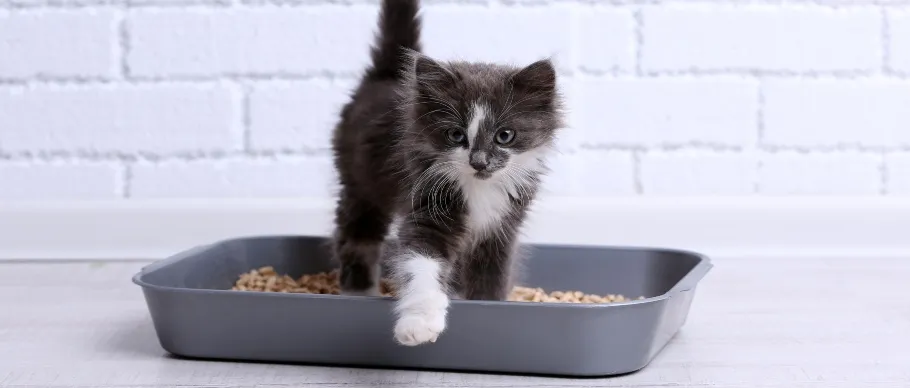One of the joys of cat ownership is how instinctively most felines take to litter box training. Unlike puppies that may take weeks to grasp the concept, kittens often head straight for their litter box, thanks to natural behaviors or subtle guidance from their mother. However, whether you’ve just adopted a kitten or brought home an adult cat, some litter training may still be needed to ensure success. In this guide on how to litter train a cat, we’ll cover essential supplies, proven steps, and cleaning tips to make the process seamless for you and your pet.
If you’re new to cat training, building good habits early sets the foundation for other behaviors too. For instance, check out how to train your cat to high five for fun tricks once basics are mastered.
Gather the Right Supplies First
Before diving into how to litter train a cat, stock up on the essentials to set your feline up for success. You’ll need:
- A litter box suited to your cat’s size, age, and breed
- Quality cat litter
- Cat pads for extra protection
- A durable litter scoop
Litter boxes vary widely—open pans, covered hoods, or space-saving corner designs. Select one at least 1.5 times your cat’s length for comfortable digging and turning. Clumping litter remains the top choice because it forms solid clumps when wet, simplifying scooping and waste removal. Fill the box with about 2 inches of litter to allow natural burying instincts.
For added mess protection, place cat pads beneath the box. These absorbent pads catch any overspray and feature paw-friendly textures. According to veterinary experts, proper supplies reduce stress and prevent accidents, promoting faster litter box training.
4 Essential Steps for Litter Box Training
Follow these straightforward steps to teach your cat to use the litter box reliably.
Step 1: Choose the Perfect Location
Place the litter box in a quiet, low-traffic area away from food and water bowls. Cats are private creatures and dislike eliminating near eating spots—this is a common reason for avoidance. A bathroom, laundry room, or quiet corner works best. Keep it accessible but secluded to encourage use.
Step 2: Introduce the Litter
Pour 2 inches of litter into the box. Gently place your cat inside to explore the texture and scent. They may sniff, paw, or even eliminate right away. Kittens especially respond well to this sensory introduction, mimicking wild behaviors of digging in soil.
 Kitten leaving litter box
Kitten leaving litter box
Step 3: Reinforce with Routine and Praise
Place your cat in the box 3-4 times daily, especially after meals when elimination is likely. Kittens often need to go within 15-30 minutes post-eating. If you catch them squatting elsewhere, calmly interrupt and carry them to the box. Praise lavishly with treats or petting upon success—this positive reinforcement, backed by animal behaviorists, speeds learning.
Building on basic habits like litter training can extend to other skills. Learn more with how to train your kitten tricks.
Step 4: Troubleshoot if Needed
No progress after a few days? Experiment with locations or litter types—some cats prefer unscented, fine-grained varieties over scented or coarse ones. Avoid punishment, as it creates fear and setbacks. Consult a vet to rule out medical issues like urinary tract infections (UTIs), which affect up to 10% of cats annually per the American Veterinary Medical Association (AVMA).
Patience pays off; most cats adapt within days. For broader behavior tips, see how to get a cat to behave.
Daily and Weekly Cleaning Routine
Scoop waste daily using a sifting tool to remove clumps, then top off litter levels. This maintains freshness and hygiene, discouraging box avoidance.
Perform a deep clean weekly: Dump all litter, wash the box with mild soap or pet-safe disinfectant (avoid harsh chemicals like bleach), dry thoroughly, and refill. Regular cleaning prevents bacterial buildup, reducing UTI risks—a key concern for cat health as noted by the ASPCA.
Proper maintenance ensures your cat views the box as a clean, appealing spot.
Final Tips for Long-Term Success
Mastering how to litter train a cat boils down to consistency, the right setup, and positive vibes. Observe your cat’s schedule—many go after naps or play—and preempt accidents. Multi-cat homes may need one box per cat plus one extra.
For sitting commands as part of routine training, explore how to train my cat to sit.
In summary, with these steps, your cat will be a litter box pro in no time, keeping your home clean and stress-free. If issues persist, seek advice from a veterinarian for personalized guidance. Share your success stories or questions in the comments—happy training!
